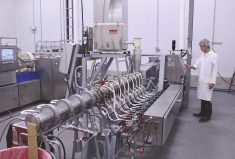It seems like something you should be reading in a cheap sci-fi novel, not in a magazine for farmers, but this is how urbanites might grow their own food in future if one Mexican company has its way.
Today, if you want to grow food in a city, you grow it beside or in between some buildings, or if you’re really eager, on top of them.
The new idea by contrast would construct city buildings out of materials that the residents could grow food in.
Read Also

What to consider when setting up farm-related business ventures
Things to consider before launching a farm-adjacent side business.
It sounds way out of their substrate, but the concept already has a name — “agritecture” — and it’s creating real interest.
“It all starts with possibilities,” says David Zampini, head of global research and development for Cemex, a Mexican multinational building materials company. “Agritecture is thinking about new possibilities for using materials to drive a new form of architecture. In this particular case, we’re talking about the possibility of growing vegetation, or farming, if you like, on a substrate, which happens to be concrete.”
Green walls are catching on in many cities. Basically, a green wall is just a wall made of concrete, wood or other material that has pockets, shelves or other systems for holding a growing medium, usually soil or nutrient-dense water, in which vegetation can grow.
Cemex, by contrast, has developed a way to integrate the growth of the plant into the concrete itself.
Zampini says the initial research into agritecture was driven by the concept of providing better nutrition for people, closer to home.

There’s another key consideration too. Food is attracting intense attention in global climate change talks. “We were talking to some potential investors and they were saying, if you track the CO2 footprint of tomatoes, for example, they travel quite a distance prior to reaching the supermarket, and consequently have a high CO2 footprint,” Zampini says.
“What was appealing to them was that most building uses concrete, and if we could turn that concrete into something that could provide nutrition, and it would be a big deal because we would reduce the CO2 footprint, and give the possibility for people living in dense urban cities to understand the concept of crop rotation, get them closer to nature, and provide food in their daily lives.”
Changing how we define space
Cemex has been working with researchers at McGill University in Montreal who are trying to perfect systems for vertical farming. One of the issues they have had is that vertical farms are usually limited to a single crop, making it hard to practice crop rotation. But growing plants in concrete could offer a solution for the problem.
“Some of these concrete elements, where we can grow crops, are quite light so there’s a lot of talk about motorizing walls,” Zampini says. “Today, the way we think of a building as an envelope, with walls where you define space in a definitive way, but what if you are no longer constrained to do that? If you can motorize the walls, you can move them and adjust the space you live in, and given that these walls can move, that means the vegetation that comes along with these walls can go into areas of the building or house where the environment is slightly different, maybe where there’s more sun or more humidity, and thereby favour crop rotation. We are trying to provoke a change in the way things are being constructed, and in the way that agritecture should evolve.”
One of the biggest hurdles in developing the technology, Zampini says, and the reason that the company was keen to work with McGill, was they need to understand the agriculture part of the equation, essentially what the plants need to grow and thrive.
“At the beginning, there were a lot of variables in terms of trying to understand what would it take to make the plants grow healthy,” Zampini says. “There were challenges because there were issues about how much water could the concrete take in and hold, and how to create a system that could circulate the nutrition properly.”
A special, water-permeable concrete was developed to manage water uptake and rooting of the plants. The concrete technology is unique because it is made with a binder that has a low CO2 footprint — up to 70 per cent lower — than conventional concrete.
Because the plants are growing under a completely different environment, even how they were rooting and gaining nutrition was completely different.
“That’s where McGill played a very important role,” Zampini says. They found the plants rooted differently in the concrete system, but the crop overall responded the way it should given the conditions and the environment. “It’s still a valid way for the plant to grow, and it’s reacting as it should,” Zampini says.
Who will invest?
It’s a concept in its infancy, and as with many new ideas, it isn’t clear yet who the potential stakeholders and drivers of this technology will be. “Will it be government, or private business?” Zampini asks. “I think it’s a bit of both.”
The challenge is to turn the concept into a value proposition, given that agritecture is little known in urban contexts.
“Architects still have to digest what it means to have this possibility and revisit how they would propose architecture in light of these new possibilities,” Zampini says. “One of our strategies is to start identifying key architectural firms that are willing to explore new avenues in terms of architecture.” It can be a challenge too because construction companies would also have to learn new techniques and processes, and they’d need to see a reason to switch away from the tried and true.
The outlook is brightening, though, as more and more architects graduate from universities with training in sustainable design and construction, something that was unheard of a few years ago. With the challenges that will be presented by climate change, and urbanization continuing at a rate that will see almost 70 per cent of the world’s population living in cities by 2050, mitigating climate and growing food in an urban environment will increasingly be front and centre in urban planning and design.
“I believe that agritecture will be the way to construct in the future,” Zampini says.
“When COVID hit, we talked to a lot of architects and a key trend was a lot of people want to start taking their lives under their own control,” Zampini says. “For example, because of energy expenditure and the cost of energy going up, people who are designing homes in the future will want to make sure that their house is energy efficient, and would rather spend more to do that because they know they have some control over how they’re managing the energy of their building. I think people will also want to have more control over how they are providing for their nutrition, or impacting the environment, and this solution will be appealing.”















